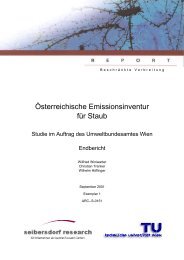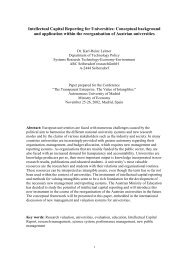ALPMON FINAL REPORT - ARC systems research
ALPMON FINAL REPORT - ARC systems research
ALPMON FINAL REPORT - ARC systems research
Create successful ePaper yourself
Turn your PDF publications into a flip-book with our unique Google optimized e-Paper software.
Contract ENV4-CT96-0359 <strong>ALPMON</strong><br />
Table 20: Synthesis of the customer evaluation for erosion risk.<br />
Item Strong Points Weak Points<br />
<strong>ALPMON</strong> Land<br />
Cover mapping<br />
from Remote<br />
Sensing<br />
Auxiliary data<br />
acquisition and<br />
harmonisation<br />
(geology,<br />
geomorphology)<br />
� Demonstrates the feasibility of<br />
realisation of an up-to-date land<br />
cover mapping over the whole<br />
regional Alpine area.<br />
� Thematic content and accuracy is<br />
generally compatible with the<br />
fundamental requirements of<br />
erosion risk assessment.<br />
� The implementation of the erosion<br />
risk model has pushed the<br />
acquisition and harmonisation of<br />
auxiliary data until now spread<br />
among several administrations<br />
and very heterogeneous. The<br />
harmonised data will turn out to be<br />
very useful also for other land<br />
planning applications of the<br />
Customer.<br />
� The auxiliary data, once scanned<br />
and georeferenced, have been<br />
delivered to the local<br />
administrations which previously<br />
supplied the original information<br />
on printed format, allowing them to<br />
put the information in their GIS.<br />
Erosion model � The FSTAB model is particularly<br />
interesting for planning purposes<br />
because: 1) it accounts for several<br />
erosion phenomena; 2) unlike<br />
other models, it gives a measure<br />
of the erosion risk instead of the<br />
predicted amount of removed soil.<br />
� The sub-model DA, built over a<br />
statistical analysis of ground<br />
surveys and extrapolated to the<br />
whole test site area using<br />
distributed data (including land<br />
cover) seems a promising<br />
approach to the zoning on the<br />
basis of soil static conditions.<br />
3.3 Technical Project Evaluation<br />
� The geometric resolution of the<br />
employed satellites is not enough<br />
detailed to detect the presence on<br />
the surface of potentially unstable<br />
incoherent materials (e.g. debris<br />
flows). In other words, while the<br />
satellite sensors used in <strong>ALPMON</strong><br />
are suitable for land cover<br />
mapping, they are still not<br />
satisfactory for geomorphological<br />
mapping. Pixel resolution of 1<br />
metre should be required.<br />
� The quantitative verification of a<br />
potential risk index is rather<br />
difficult.<br />
� In displaying the MEHI erosion risk<br />
index, the choice of the right<br />
slicing levels of the index is very<br />
critical for the correct interpretation<br />
of the map.<br />
� The correct choice of the threshold<br />
precipitation event for the submodel<br />
SCS-CN is rather difficult.<br />
In the following the technical aspects of the projects sub-tasks as well as the feasibility studies are<br />
evaluated from the project teams point of view.<br />
JR, RSDE, ALU, LMU, Seibersdorf, WSL 74




